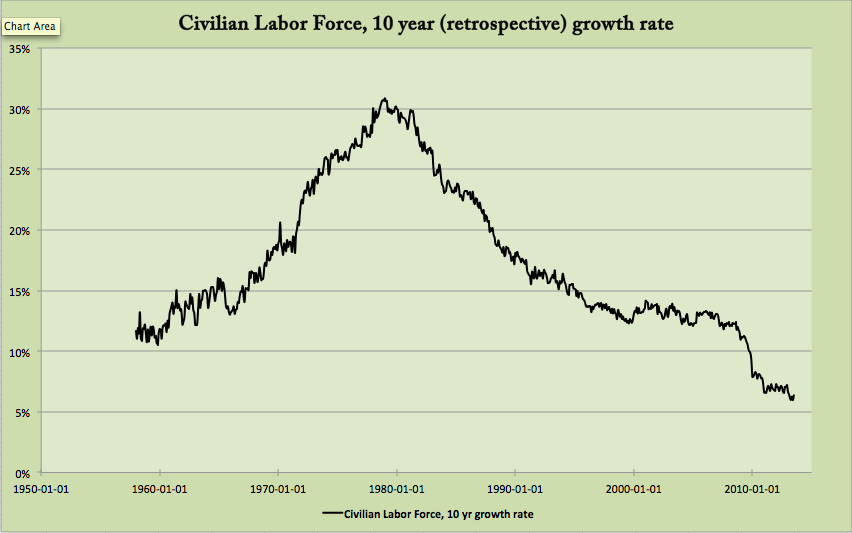Steve Randy Waldman delivers another Aha! post (and a followup reply to Scott Sumner) pointing out a huge driver of the 1970s Great Inflation — the rise in the labor force:

Between the mid 60s and the mid 70s, the labor force grew by 30%.*
Steve, emphasis mine:
The root cause of the high-misery-index 1970s was demographics, plain and simple. The deep capital stock of the economy — including fixed capital, organizational capital, and what Arnold Kling describes as “patterns of sustainable specialization and trade†— was simply unprepared for the firehose of new workers. The nation faced a simple choice: employ them, and accept a lower rate of production per worker, or insist on continued productivity growth and tolerate high unemployment.
Capitalists didn’t have the capacity to justify employing all those workers at the prevailing wage. The only way to employ them was to lower real wages (always sticky in real terms) via inflation. The Fed accommodated that, favoring employment over wage control. The alternative would have been massive unemployment of all those eager up-and-coming boomers. Would that have been A Good Thing?
I’ve been worrying at the various Great-Inflation explanations for a decade, and I’ve never found them satisfying. Some seeming errors and contortions of economic logic aside, the imputed causes (OPEC?) have just never seemed big enough to bring about the massive economic effects we encountered.
This definitely does. Steve has added a (maybe the) crucial piece that allows me to understand this period.
Do monetarists really want to argue that the “stag” part of stagflation (unemployment) would have been the same if the Fed had gone Volcker in 1975? They were facing a tradeoff driven by a massive demographic shift. Incorporate that shift in your thinking, and you can ask the important question: would excluding those new workers (“financial repression!”) have been worth it, in return for lower inflation? (Inflation that eviscerated the real buying power share of financial-capital holders and creditors.)
You can argue about the answer, but this is sure: the rise in the labor force that Steve points out is crucial to thinking about The Great Inflation, and it’s been completely absent from the mainstream-storyline Great-Inflation explanations that I’ve wrestled with over the years. Viz two epitomes of that mainstream here and here. Neither one even mentions the labor force.
* This also of course involving what is perhaps the single largest macroeconomic shift from the 60s to the turn of the millenium: women entering the work force:

Over the 60 years following WWII, women’s labor-force participation jumped from 35% to 75%. In the 70s alone it jumped from 50% to 65%.
Cross-posted at Angry Bear.
Comments
6 responses to “Did the Baby Boom Labor Force Surge Cause The Great Inflation?”
[…] Cross-posted at Asymptosis. […]
[…] Cross-posted at Asymptosis. […]
[…] Steve Roth — Did the Baby Boom Labor Force Surge Cause The Great Inflation? […]
[…] in the blogosphere. See Kevin Erdman, Edward Lambert [1, 2, 3], Marcus Nunes [1, 2], Steve Roth [1,2], Mike Sax, Karl Smith [1, 2, 3], Evan Soltas, and Scott Sumner [1, 2], as well as a related post […]
[…] Steve Roth — Did the Baby Boom Labor Force Surge Cause The Great Inflation? […]
I missed this when you posted it, but I feel vindicated. I’ve been trumpeting this phenomenon of the 1970s (OK, talking about it) for a long time. What was Carter to do (and Ford in his short time) except do his best to balance competing worries while being whipsawed with the arrival of the Baby Boomers en masse, and with young women demanding like never before to become part of the work force? The growth of the labor market generally in the 1970s was huge; the growth of the young female labor force astounding.